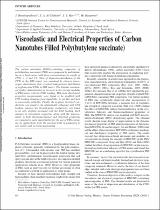 ResearchSpace
ResearchSpace
Viscoelastic and electrical properties of carbon nanotubes filled poly(butylene succinate)
JavaScript is disabled for your browser. Some features of this site may not work without it.
- ResearchSpace
- →
- Research Publications/Outputs
- →
- Journal Articles
- →
- View Item
| dc.contributor.author |
Bandyopadhyay, J

|
|
| dc.contributor.author |
Al-Thabaiti, SA

|
|
| dc.contributor.author |
Ray, SS

|
|
| dc.contributor.author |
Bousmina, M

|
|
| dc.date.accessioned | 2014-09-16T12:19:57Z | |
| dc.date.available | 2014-09-16T12:19:57Z | |
| dc.date.issued | 2014-03 | |
| dc.identifier.citation | Bandyopadhyay, J, Al-Thabaiti, S.A, Ray, S.S and Bousmina, M. 2014. Viscoelastic and electrical properties of carbon nanotubes filled poly(butylene succinate). International Polymer Processing, vol. 29(1), pp 88- 94 | en_US |
| dc.identifier.issn | 0930-777X | |
| dc.identifier.uri | http://www.hanser-elibrary.com/doi/abs/10.3139/217.2812 | |
| dc.identifier.uri | http://hdl.handle.net/10204/7671 | |
| dc.description | Copyright: 2014 Carl Hanser Verlag. Published in International Polymer Processing, vol. 29(1), pp 88-94 | en_US |
| dc.description.abstract | The carbon nanotubes (CNTs)-containing composites of poly(butylene succinate) (PBS) were prepared by melt-blending in a batch mixer with three concentrations by weight of CNTs: 1, 2 and 3 %. State of dispersion-distribution of the CNTs in the PBS matrix was examined by electron microscopic observations that revealed homogeneous distribution of agglomerated CNTs in PBS matrix. The dynamic mechanical studies demonstrated an increase in the storage modulus of PBS matrix with the CNTs loading. Melt-state rheological properties measurements were found to be modified with CNT loading changing from liquid-like, to gel-like and then to viscoelastic solid-like. Finally, the in-plane electrical conductivity was found to be substantially enhanced with CNT loading, whereas the through-plane conductivity was found to be only slighted increased with the CNT loading. Such changes in viscoelastic properties along with the improvements in both thermomechanical and electrical properties are expected to open opportunities for the use of PBS extending its applications from the classical field of packaging to new niches such as tissue-engineering. | en_US |
| dc.language.iso | en | en_US |
| dc.publisher | Carl Hanser Verlag | en_US |
| dc.relation.ispartofseries | Workflow;13381 | |
| dc.subject | Carbon nanotubes | en_US |
| dc.subject | CNTs | en_US |
| dc.subject | Poly(butylene succinate) | en_US |
| dc.subject | PBS | en_US |
| dc.title | Viscoelastic and electrical properties of carbon nanotubes filled poly(butylene succinate) | en_US |
| dc.type | Article | en_US |
| dc.identifier.apacitation | Bandyopadhyay, J., Al-Thabaiti, S., Ray, S., & Bousmina, M. (2014). Viscoelastic and electrical properties of carbon nanotubes filled poly(butylene succinate). http://hdl.handle.net/10204/7671 | en_ZA |
| dc.identifier.chicagocitation | Bandyopadhyay, J, SA Al-Thabaiti, SS Ray, and M Bousmina "Viscoelastic and electrical properties of carbon nanotubes filled poly(butylene succinate)." (2014) http://hdl.handle.net/10204/7671 | en_ZA |
| dc.identifier.vancouvercitation | Bandyopadhyay J, Al-Thabaiti S, Ray S, Bousmina M. Viscoelastic and electrical properties of carbon nanotubes filled poly(butylene succinate). 2014; http://hdl.handle.net/10204/7671. | en_ZA |
| dc.identifier.ris | TY - Article AU - Bandyopadhyay, J AU - Al-Thabaiti, SA AU - Ray, SS AU - Bousmina, M AB - The carbon nanotubes (CNTs)-containing composites of poly(butylene succinate) (PBS) were prepared by melt-blending in a batch mixer with three concentrations by weight of CNTs: 1, 2 and 3 %. State of dispersion-distribution of the CNTs in the PBS matrix was examined by electron microscopic observations that revealed homogeneous distribution of agglomerated CNTs in PBS matrix. The dynamic mechanical studies demonstrated an increase in the storage modulus of PBS matrix with the CNTs loading. Melt-state rheological properties measurements were found to be modified with CNT loading changing from liquid-like, to gel-like and then to viscoelastic solid-like. Finally, the in-plane electrical conductivity was found to be substantially enhanced with CNT loading, whereas the through-plane conductivity was found to be only slighted increased with the CNT loading. Such changes in viscoelastic properties along with the improvements in both thermomechanical and electrical properties are expected to open opportunities for the use of PBS extending its applications from the classical field of packaging to new niches such as tissue-engineering. DA - 2014-03 DB - ResearchSpace DP - CSIR KW - Carbon nanotubes KW - CNTs KW - Poly(butylene succinate) KW - PBS LK - https://researchspace.csir.co.za PY - 2014 SM - 0930-777X T1 - Viscoelastic and electrical properties of carbon nanotubes filled poly(butylene succinate) TI - Viscoelastic and electrical properties of carbon nanotubes filled poly(butylene succinate) UR - http://hdl.handle.net/10204/7671 ER - | en_ZA |





